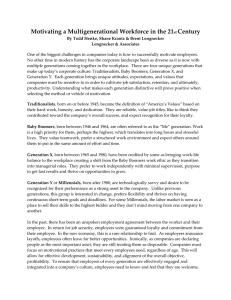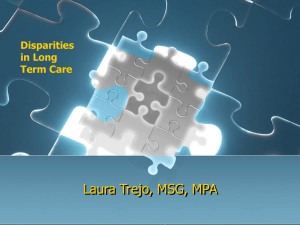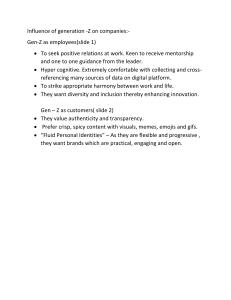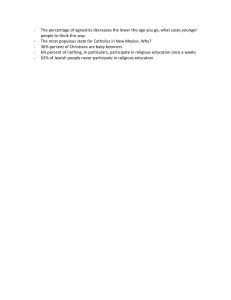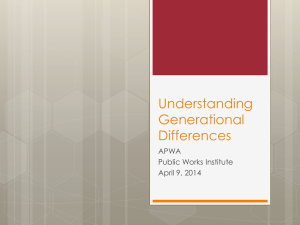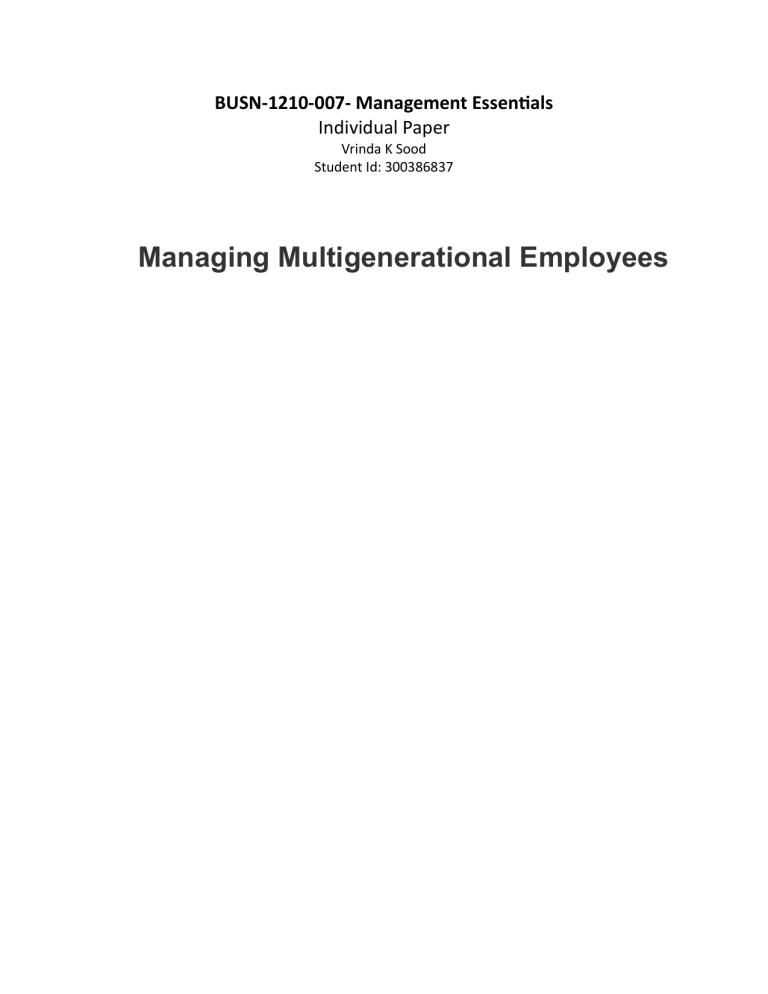
BUSN-1210-007- Management Essentials Individual Paper Vrinda K Sood Student Id: 300386837 Managing Multigenerational Employees Introduction It is no surprise that managers in today’s day and age must manage employees of a variety of age groups. One of the contributing factors is an increase in the young workforce and a delay of retirement age due to economic factors. The workplace is increasingly characterized by a multigenerational composition, with individuals from different age groups, such as Baby Boomers, Generation X, Millennials and Generation Z, working together. In the contemporary workplace, employers face a formidable challenge in motivating a multigenerational workforce. The coexistence of Baby Boomers, Generation X, Millennials, and Generation Z employees has given rise to an unprecedented diversity of expectations and values. This diversity has forced organizations to adapt their motivational strategies to cater to the distinct needs of each generation, recognizing that a one for all approach is no longer effective. Generational diversity in the workforce is a complex and multifaceted issue, with each generation bringing a unique set of experiences, preferences, and work styles to the table. Baby Boomers, raised in the post-World War 2 era, value job stability, loyalty, and traditional workplace structures. Generation X, seeks work-life balance, autonomy, and independence. Millennials, the tech-savvy cohort, prioritize purpose, social responsibility, and continuous development. Meanwhile, Generation Z, who are born in the “digital age”, crave innovation, instant feedback, and opportunities for self-expression. The challenge for organizations is to create motivation strategies that align with these differing generational expectations, all while fostering a harmonious and productive work environment. The challenge at hand is to navigate these nuances. It is about acknowledging these differences and curating strategies to cater to each of the employees that resonate with unique aspirations of each age group. The task at hand is to balance the scale with employee motivation, productivity and satisfaction on one end and harmonious teamwork on the other end, with these differences staring the management in the face. While writing this research paper, I understood the actual differences in goals and objectives of the employees depending on their age group. This in turn, affects the incentives that motivate them. The importance of understanding how to motivate multigenerational workforce cannot be overstated. It Is not just a matter of present but of utmost strategic importance for organizations to sustain their business. This research paper delves into various strategies to motivate employees whilst considering the factors that might affect the said strategies. Most of the organizations today have an array of employees. Their individualities are based on their ethnic differences, unique personalities, political beliefs, et al. In this paper, we are looking at their differences based on the age group they fall in. The differences can be gauged based on their experiences, the era that they are born in, to name a few. As discussed in the introduction, formulating specialized strategies to provide support to everybody’s interests is of the utmost importance. It is crucial for employee satisfaction and thereby, increases productivity of the organization. The article considers a multitude of factors that impact motivation amongst the employees. The question at hand is whether motivation needs are interchangeable within generations. Prior to getting into the actual motivational models, we need to consider various theories that have been developed over the years. • Maslow’s Hierarchy of Needs This theory is based on how an individual works or is driven to work on a set of needs. Physiological needs are considered as the basal ones in this hierarchy. These include food, shelter, clothing, a sense of security, feeling of well-being. These needs are found to drive the Baby Boomers the most. Social needs include friendship, belongingness love and affection. These can be a common point of motivation for all the generations, precisely for the Baby Boomers. Self-esteem needs refer to a sense of recognition, bonuses, promotions and rewards, all of which are more dominant in Generation X and the Millennials. The highest in the order are self-actualization needs that give a sense of purpose to the employees. This is also predominant for all the generations. • Herzberg’s Two-Factor Theory This theory is also called motivation-hygiene theory. According to this theory, unfulfillment of lower needs cause dissatisfaction in the employees. The lower needs include working conditions, policies of the company, relationships of team members, pay and ineffective supervision to name a few. On the contrary, the motivation factors that aggravate motivation that enhance employee satisfaction are recognition, job responsibility, achievement, and job advancement/promotions(Herzberg, Mausner & Snyderman,1959) • McClelland’s Theory of Needs This theory developed in 1960’s focuses on three needs: achievement need-based on challenging goals, autonomy, risk taking; power need- based on desire to control and influence others, status, and recognition; affiliation need- based on group collaboration preferences, less risk taking. • McGregor’s Theory X and Y This theory assumes that employees are lazy and do not wish to perform. Theory X supports that employees must be pressured into working. Theory Y concludes contrarily to the former one. It says employees like to work, seek responsibility and are innovative. Let’s look at the contemporary theories of motivation. • Goal Setting Theory: This was developed by Edwin Locke and Gary Latham in the 1960’s. It uses the principle that targets a particular task to achieve higher performance. This theory states that the behavior is only impacted by goal setting only. The higher the goal, higher is the performance. • Equity Theory This was developed by J. Stacy Adams in 1963. It explains how an individual gets motivated if dealt with fairness and equitable social comparison. What one is putting in the job, also known as the effort and what one gets out of the job, known as reward, are compared by the employees amongst themselves. • Reinforcement Theory This was developed by Skinner that works on the principle of reinforcers for the individuals. It states that if the outcomes are positive, that behavior gets reinforced, while unfavorable outcomes lead to termination of that behavior(s) Management Strategies to Motivate Employees: • Management by Objectives This strategy is a derivative of the Goal Setting Theory. It works on the principle of setting goals for the employees and achieving them in a particular time frame. The incentives can be rewards, recognition and compensation for the employee. Feedback systems are put in place for manager-employee rapport for progress tracking. This method is applicable to all the generations. • Employee Recognition Program This program is to acknowledge specific employees. This works on Skinner’s Reinforcement Theory. Rewarding positive behaviours will result in the repetition of the said behaviors. Baby Boomers prefer a formal recognition in front of employees, Gen X prefers recognition in private settings while Millenials prefer recognition in terms of novel experiences (Schweyer,2015). • Incentive Compensation Plans These are also known as pay for performance plans. In simple terms, the higher your productivity is, or the more your output is, more will be your pay. These “payments” can be in the form of bonuses, among other rewards. • Work-Life Balance The need of having a balance between work and life and a sense of meaning to work has increased exponentially in the recent times. The newer generation seeks this in their personal and professional lives. It keeps the employees engaged, satisfied and motivated, all of which are established already increase productivity. Conclusion Taking this article and the current day-to-day into account, managing different generation in workplace is quite the inevitable. It is something that cannot be escaped. The organizations that can or have the potential to survive and thrive are the ones that maneuver these nuances. It is understandably a little difficult to navigate, catering to everybody’s different personalities and perspectives. However, the theories and motivation strategies that have been discussed, clearly shed a light on how early theories and the contemporary ideologies intertwine with each other. It is a beautiful example, how both old and new ideas complement each other and the outcome of combining them can result in a productive outcome, that are favorable to both the employees and the organization. Citation Cote, Robert (2019). Motivating Multigenerational Employees: Is There a Difference? Vol 16 Issue 2 DOI
